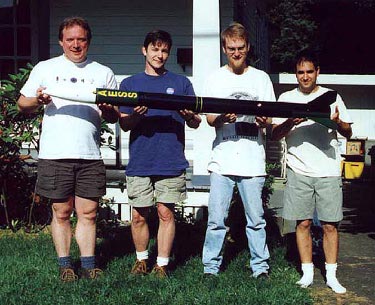
Launch Vehicle 0
Glenn LeBrasseur, Brian O'Neel, Bjorn Skyberg, Andrew Greenberg
Holding LV-0 prior to maiden flight at Monroe, Washington 6/7/1998
LV-0 is the first rocket built by the AESS group. It is essentially a modified kit rocket that is sold by LOC/Precision out of Ohio. Our modifications were as follows :

Addition of payload section for camera and telemetry.
Removable 38mm motor mount to allow for later 54mm motor if desired
Separate Body and Payload recovery systems.
Sling the Payload section to allow camera good decent view.
Fiberglass reinforcement of body,fins, and motor mount
The rocket as purchased was less than 2 lbs and designed to fly on 29mm motors with approximately 120 N.s. Our final vehicle ended up weighing in at a whopping 12.2 lbs. and used a 38mm motor with 700 N.s.
LV-0 Specifications :
| THE ROCKET : | |||||||||||
| Construction | Cardboard reinforced with 3 layers of 9oz E-glass | ||||||||||
| Overall Length | 72.00 " | ||||||||||
| Max. Diameter | 4.07 " | ||||||||||
| Total weight (w/ payload) | 12.2 lbs | ||||||||||
| Center of Pressure | 53.3 " from nose tip | ||||||||||
| PAYLOAD SECT. : | |||||||||||
| Overall Length | 38.00 " | ||||||||||
| Nose Cone | 12.80 " | ||||||||||
| Payload bay | 25.20 " | ||||||||||
| MAIN BODY : | |||||||||||
| Overall Length | 34.00 " | ||||||||||
| Boat tail | None | ||||||||||
| Number of Fins | 3 | ||||||||||
|
|
||||||||||
| Launch Lugs | (2) 0.5 " | ||||||||||
The body and payload sections were friction fitted together and powder graphite was used as a lubricant. The two sections are separated at apogee by gas pressure from the ejection charge of the motor.
The payload electronics rail was hard mounted to the nose itself and the nose was screwed into through the payload bay wall. The payload and rails were heavy enough that we had concerns the inertia might rip the nose and rail system from the payload bay upon deployment of the parachutes. We did a little hasty reinforcement and added a flashy silver band of duct tape just to be cool and the payload fared just fine.
No simulations or pre-flight testing was done beyond that of a simple center of gravity/ center of pressure relationship and a check on the thrust to weight ratio. The flight ended up being less than stable do to a small fin surface area and a slow air speed of the end of the launch rod. We used the fins that were supplied with the kit and would have been better of adding our own larger ones. Future flights on this vehicle should be aerodynamically stable if we remove a couple of pounds of dead weight from the nose (this will still insure a margin of stability of at least 2 calibers) and use a somewhat longer launch rod to ensure a higher exit velocity of the stand.
We will probably use the LV-0 to test some of the upcoming electronics systems and accelerometer and gyro packages but work is currently going forward on the larger LV-1 vehicle for launch in Aug. 98.